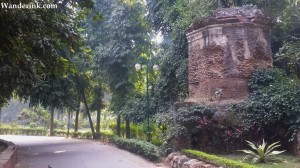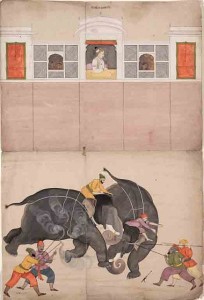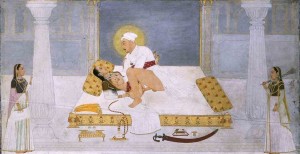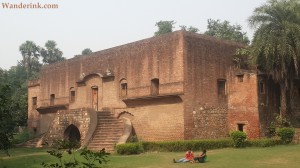What do you wear when you are soon going to doff it for a copulation session for canvas? What was that semaphore again for more shisha in the hookah? How long does one keep jigging for the frolicsome mood to be captured as still life? At the Qudsia Bagh in Civil Lines I tried to lay a handle on some possible existential crises of Mohammad Shah ‘Rangeela’ (‘The colourful’), one of whose begums built the eponymous garden. The crossdressing debauchee was also the longest serving Mughal emperor since Aurangzeb. Well, he lasted long – nearly three decades from 1719 to 1748 – largely because he busied himself with these more, well, immediate issues rather than the regular drawn-out ones like, say, war strategies and kingdom expansions. He also didn’t engross himself much with a popular pastime of the period which enjoyed regal patronage, an activity which led to the untimely – and mostly gory – demise of seven rulers in the 12 years before him – conspiratorial killing of blood relations posing any threat to your own ascension.
While plenty has been known, envied, and seen of Rangeela not much has been written about the Qudsia Bagh, garden, which could be because not much is left of it. A sprawling pleasure garden, this was at par with the famed Vauxhall along the Thames and laid out in 1748 typically along the banks of the Yamuna which later decided to course further east. Where the river once flowed is the Ring Road today. The English retribution following the uprising of 1857 saw to it that the stately ornate buildings and winding water pathways of the garden were rendered vengefully mouldered. Development and related encroachment in an independent India saw the garden wither to 50 and then 30 acres. Today local estimates place the area at a vastly diminished 20 which is expected to shrink further once the ongoing work on the Metro line next to it is complete. And with it turn away many birds, including rare migratory ones, which pass by.
As shrivelling green lungs vanishing verdure seem to be a matter of distant if not a concern soon receding-into-irrelevance for the city dwellers. This is going by the pollution levels which, during Diwali this year reached 17 times the prescribed danger limit. In a city where every third child has a respiratory condition there was little thoughtful cessation in the cracker-bursting revelries. The gasping situation has provoked no active curbs from the authorities and the condition is projected to get worse with the marriage season around the corner.
But what subsumed me at the moment was the wonderful and massive gateway unimaginatively called the ‘Haathi Darwaza.’ (Massive gateways all over India are called ‘Haathi Darwaza’; I shan’t be surprised if in all these cases it is ASI the unimaginative godfather.) Trying to make up for what the ASI lacked I imagined Qudsia Begum enter the garden sitting astride an elephant. Not very far-fetched by any yardstick. Quli Khan in his travelogue Muraqqa-i-Dihli (The Delhi Album) chronicling the Sufi saints and dance girls and rent boys of Delhi under Rangeela also mentions a Nur Bai who travelled only on elephants who ‘ruined many houses.’ (You should join the ASI if you think this destruction was brought on by trampling.)
Qudsia Begum was originally Udham Bai. A gifted dancer, Udham Bai’s seductive moves charmed Rangeela who soon married her. Udham Bai thus became Qudsia Begum who went on to create one of the finest pleasure gardens in the world at the time probably replete with its own promenades, bandstands, fountains and maybe a harem even to ensure her husband visited often. It might have been difficult to hold on to a lotus-eating emperor whose pleasure-seeking pursuits covered the whole gamut from fetish to fear. Widely spotted in women’s clothes, he was rumoured to have been impotent – to counter which, it’s said, some of the paintings were commissioned. The most noteworthy that of him fornicating in near nudity, female attendants fanning draught and desire. Others include a celebration of Holi, watching an elephant fight from a safe height and another framed by a jharokha. This style of painting pioneered by Nidha Mal grew to be a rage among other rulers. Rangeela could have sucked on his hookah, straddled the courtesan or cut a rug for the paintings in the garden where I was strolling now.
By the side of the path leading to the gateway were the derelict ruins of a pillar with peeling stucco baring the ordered maze of fine Lahori brickwork beneath. Corbel remains pointed to a taller and probably more elaborate structure. Tousled with creepers, determined some clung to it concealing open wounds – preserving whatever of the grandeur left. Inside the Darwaza I was flanked by not dark, dingy sally ports, a fort staple, but stairways that wound all the way up to an airy, sunny terrace. It seemed to have been once sequestered from view by columns with florid motifs; what remained were baroque bases and bulbous stubs of tops awaiting further beheading by a passing gryphon. Hundreds of pigeons arose in a cooing flutter like they do ahead of the hero and heroine running in slomo holding hands with the Gateway or India Gate in the background. Some did a flying scat protest as I stepped into their cereal breakfast just served by the garden attendant.
Govind’s un-washed, oversized shirt fell like a soutane. A gormless but otherwise avuncular man, he carried the harried air of a single working mother on a PTA Saturday. He paused for my questions and itched out his answers from his balls.
‘The British built so many buildings all over Delhi. Nobody should expect me to remember their names.’ This was the gist of what he said before shuffling away now trying to positively pry his balls out. I walked away before he could lob them at me in case he succeeded.
Concrete walkways wound their way around the park and passed by benches where people sat mirthlessly guffawing their way into yogic longevity. If the Metro work didn’t scare away the birds, this would, I thought. Amorous youngsters, seemingly diddling to passers-by, dotted the lawns their hands disappearing into dupatta folds and jacket hems.
Rangeela was around.
 Some more action: It is true that with the passing away of Syed Ausaf Ali, the revered historian last month, nobody knows Delhi anymore like the back of their hand. But it is only fair that those employed by the ASI, like Govind (surname and photograph withheld to protect sorry identity), should at least know the history of the site they are posted to. Govind, as I said in the post, did tell me the buildings in the Qudsia Bagh were built by the British whereas most of it were destroyed by them. True, I knew about the Qudsia Bagh more or less when I visited but I didn’t know about the Mohammad Shah connection. When Govind told me it was all built by the British I felt like crying; when he said nobody should expect him to remember names I felt like kicking the body part he was busy raking.
Some more action: It is true that with the passing away of Syed Ausaf Ali, the revered historian last month, nobody knows Delhi anymore like the back of their hand. But it is only fair that those employed by the ASI, like Govind (surname and photograph withheld to protect sorry identity), should at least know the history of the site they are posted to. Govind, as I said in the post, did tell me the buildings in the Qudsia Bagh were built by the British whereas most of it were destroyed by them. True, I knew about the Qudsia Bagh more or less when I visited but I didn’t know about the Mohammad Shah connection. When Govind told me it was all built by the British I felt like crying; when he said nobody should expect him to remember names I felt like kicking the body part he was busy raking.
On the rolls of a prestigious, responsible and well-funded body, it’s not too much to expect Govind to tell me the correct history of the garden and introduce me to Rangeela. If Govind is busy feeding pigeons or dismantling his own body parts, the ASI should at least put up a board with the history on it. I shall write to the ASI as well as mark a copy to the email provided in the signboard here. Progress shall be duly noted in the comments section below.


















Action updates 1: Nov 4, 2016, 2 PM. I shot the mail given below to goitodelhi@tourism.nic.in (the email in the picture), dg.asi@gov.in (ASI director general) and intach@intach.org.
Dear sir / madam,
On a visit to the pretty Qudsia Bagh in the Civil Lines last week I came across the watchman Govind Ram to whom I enquired the names of the ruined structures. Forget the names, he didn’t have any idea of the garden’s history even.
More grievously, he misrepresented history too and told me that it was all built by the British; further shining a defiant light on his ignorance he said there are many such buildings in Delhi and he cannot be expected to remember them.
The full text of the complaint can be found in the link given below:
http://www.wanderink.com/main-story/qudsia-garden-rangeela-territory/
As an employee, possibly the only interface between a visitor and the heritage authorities, its my humble request to initiate some orientation program to all Govind Rams on your payrolls that they do not go about doling out such stupidities. While at it, they should also be told to spare their balls.
Warm regards,
Thommen Jose
Action updates 2: Soon as I sent in the complaint in action update 1, I got this notification:
Delivery to the following recipient failed permanently:
goitodelhi@tourism.nic.in
Action updates 3: Nov 4, 2016, 2:36 PM. To ensure contact with the tourism ministry, tweeted (with photograph) tagging:
Sir, can you please make mandatory some basic information and manners for ASI staff posted at site? @tourismgoi @PMOIndia @incredibleindia
Action updates 4: Nov 4, 2016, 6:30 PM. So I get the following email from one Mr Daljeet Singh, of the ASI Delhi circle. I have duly emailed the complaint to the ID provided here. Whether passing the buck in a typically bureaucratic fashion, it is nevertheless a good start. Good enough to call it a day’s work. Well, in bureaucratic circles, at least it is.
The mail is as copied under:
Sir
This matter is under the jurisdiction of ASI, Delhi Mini Circle. Email ID of Delhi Mini Circle is asidelhiminicircle@gmail.com
and Please contact to Sh. Rajender Dehori , Mobile No. 9205772843 , Office no. 24655164/62/63
Action updates 5: Nov 7, 2016, 12:35 PM. First working day of the week, I get a call from the same office which sent me the earlier mail. Its the ASI office at INA, Delhi. Phone: 011 24654833. The staff essentially told me whatever was in the mail – that the Qudsia Bagh is under the jurisdiction of the mini circle, a show run by Mr Rajender Dehori. So, I shall wait for response from the big man at the mini circle office. Best!
Action updates 6: Nov 15, 2016, 11:30 AM. Since there is no reply from Mr Dehori for over a week, I decide to call him. (I have seen many bureaucrats in government who doesn’t check their emails on computers, but wait for their flunky / junior to bring the print outs of these – a weekly or fortnightly exercise. Really.)
What he said was essentially this: Even at the Qudsia Bagh, only the gate and the mosque are under the ASI (the mini circle, which he heads – guess an attempt at a slight deflection of negligence charges that might come his way). The watchmen are just that – watch men. And its very difficult to get educated and informed people of this cadre. Now, if I wanted each and every one on ASI site to be knowledgeable about the heritage they were guarding, then there has to be an intervention from the director general himself. (Though this did sound like a full-fledged deflection now, he had a point. And I have duly mailed the director general, given below.)
Sir,
Following instructions from your mail dated Nov 4, I spoke to Mr Rajender Dehori of the ASI mini circle (mob no. 9205772843) on Nov 15, 2016. This is regarding appointing at least moderately informed guards at ASI structures; the specific complaint was wrt the Qudsia Bagh.
Mr Dehori conceded that all guards at ASI monuments are ‘simple watchmen’ only who are like any other security men, say, at an ATM. And I guess he has a point when he says that in order to have some orientation for the security guards at ASI sites, it has to come from the director general of ASI.
Hence, I am re–directing the mail to you here. Will the ASI be able to do some certain minimum intervention to see that the guards posted at ASI sites have some minimum knowledge of what they are guarding?
This is really important as they are invariably the sole tourist interface when it comes to standalone structures like the Qudsia Bagh – and there are several in Delhi.
Awaiting your reply.
Delhi has so much Heritage, its always missed. Like the thing you are searching for, right in front of your eyes.
Its not just missed but misused too…a crying shame! We just don’t value the precious in our own backyard.
Your efforts are really encouraging!
And the place is quite offbeat. I never heard about it earlier despite living nearby since the past 6 years! Will be visiting the Bagh soon!